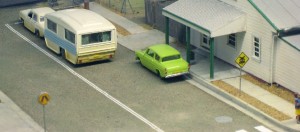Everything on model trains, model railroads, model railways, locomotives, model train layouts, scenery, wiring, DCC and more. Enjoy the world's best hobby... model railroading!
Making Roads and Sidewalks For Your Layout
John (a regular contributor) has kindly sent in this helpful article on making roads and sidewalks for a layout:
Despite the common misconception that roads are black, they are actually gray in color. Macadam appears black as its first put down or the road is resurfaced, but it quickly turns to gray and should be represented as such on a train layout. There are many products available in hobby shops for roadways, but they can also be made by hand, as long as size and scale are always crucial elements.
To make a roadway, first plan it out. Roads go somewhere, and there is an “in” and “out” off the layout, though they may be one and the same. Once your road is placed, paint it a medium-gray color and let it dry. Then it is time to add the white and/or yellow stripes if they are being used. A good place to get these stripes is in map stores that offer colored tape in various sizes.
Realism should be added to a road, which always sports some kind of spill. I model the late-1950’s on my small N-Scale layout, and while the classic vehicles for that time period are fantastic to say the least, some of them always seemed to leak something. To model gasoline, oil, and transmission spills and leaks, wait till the gray paint is dry and then brush on a wash of flat black paint in certain places. If you add too much or the road doesn’t look realistic, wipe the wash off completely while it is still wet and start over.
Sidewalks and curbs add much to a city or rural scene, and are available through a hobby shop or can be made with items around the house, heavy cardboard is one of them. The sidewalk is a concrete color, as is the curb, and should show usage. An excellent way of doing this is offered by Robert Anderson, owner of this website, who recommends dusting on baking soda while the concrete color paint is still wet, which makes the sidewalk look weathered. Another weathering technique when the paint is dry is to make small, very shallow cuts with a hobby knife to simulate cracks. Using the same wash as for the roads, brush it on and wipe it off, and the cracks in the sidewalk will show clearly. Curbs can be scuffed up by tires, or by pedestrians who have something “undesirable” on their shoe.
Doing these tasks can be time-consuming, but it is time well spent. Whether we model a prototype or specific time period, anything that approaches realism will enhance the areas in which our train(s) run, and increase the fun of model railroading.



















Leave a Reply